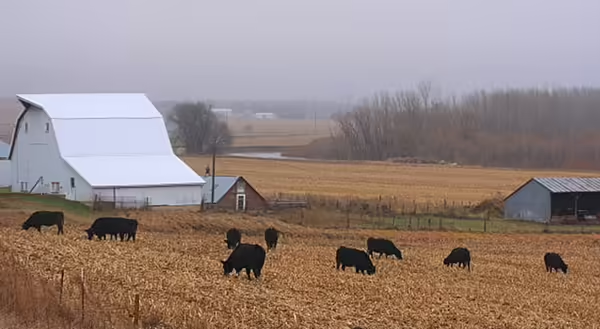
Grazing cornstalks is arguably the best cost-saving strategy Midwestern cattlemen can deploy. Here are some common questions pertaining to utilizing cornstalks.
Q: How long can I graze cornstalks?
A: This depends on stocking rate and available dry matter. At 150 bushels an acre, approximately 1 acre of cornstalks are needed to feed the cow for 30 days. To feed the same cow on cornstalks for 60 days, 2 acres would be needed. These are good numbers for budgeting. I challenge producers to continuously monitor the cattle, their behavior, and the amount of husk and leaf left in the field. Once the majority of the husk is gone, the feed value is relatively poor.
Q: Is compaction a problem?
A: Generally, not an issue. High traffic areas around water or a feeder will be more susceptible to compaction. If cows are left on cornstalks into the late winter or early spring, there is a higher risk of compaction.
Q: Do I need to supplement with additional feed or protein tubs?
A: Cattle will eat the more digestible and higher protein portions first. Therefore, a good mineral is probably the only supplementation needed for the first month unless the herd includes fall-calving cows or stocker calves. For them, a supplement will be necessary to meet nutrient demands of lactation and growth, respectively. Monitor residue available for grazing, animal behavior, and manure scores to determine supplement needs for dry cows.
Q: I have a field I can’t graze. Is it worth it to bale cornstalks and feed them?
A: If you do not have the capability to graze cornstalks, they can be baled. Baling cornstalks will add costs to the feed in the form of fuel, labor, equipment costs, and fertilizer replacement costs. Even with these costs, it can still be an economical feed. Hauling manure back to the harvested fields will displace some fertilizer costs associated with cornstalk removal. Generally, fertilizer value of a 1000-pound round bale of cornstalks is around $15. Harvesting costs must be evaluated closely.
Q: Will grazing cornstalks hurt subsequent crop yield?
A: Researchers at the University of Illinois conducted a 3 year study in central Illinois. The study looked at yields in a continuous corn rotation. The study showed no statistical difference in yield following cornstalk grazing. The authors did note lower yields on yield maps in high-traffic areas around waterers and mineral feeders. These lower yielding spots were still not enough to cause a difference in the treatments.
A ten-year study by Nebraska researchers that showed soybeans planted after grazing cornstalks yielded 3 bushel more than those harvested in non-grazed fields. Overall, allowing cattle to harvest and trample a portion of the residue has limited impact on subsequent crop yield.